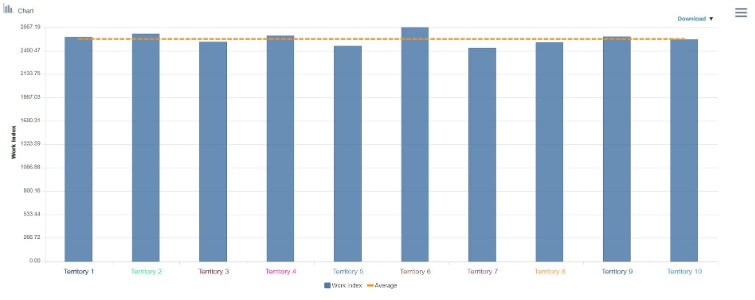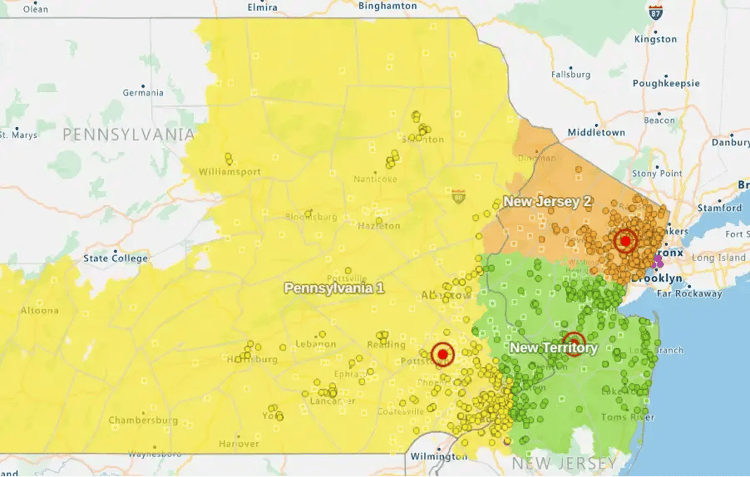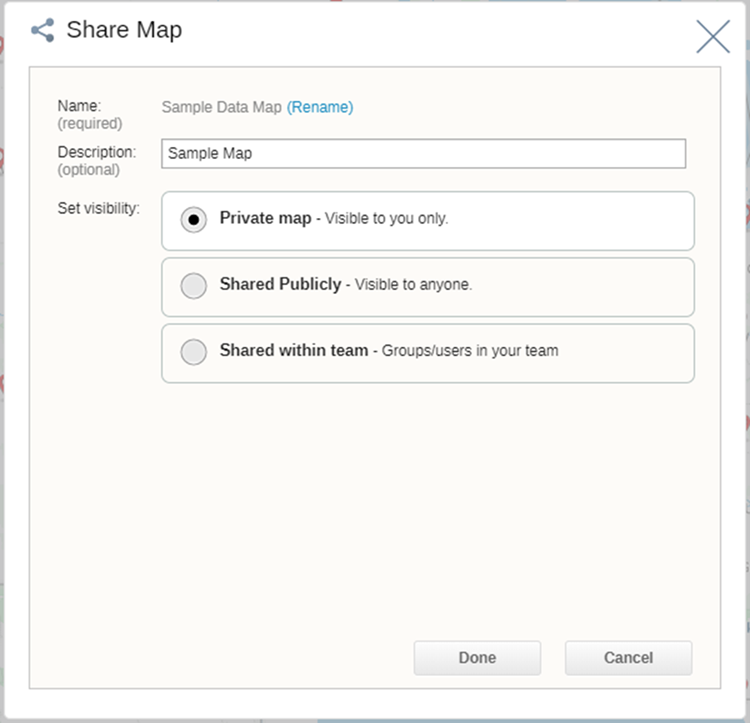Building sales territories is strategically important and results in better sales utilization, resource allocation and more revenue with less cost. It is a complex process involving many moving parts.
In this step-by-step guide, we aim to simplify and demystify the process. If you are a sales leader in sales operations, a marketing analyst, or the CEO of a small business, you'll learn the why and how to build sales territories.
1. Crunch your numbers
Collating and analyzing your sales and market data is the first step. Here is a sample of the data you'll need:
- Customer location data
- Competitor location data
- Sales potential data (we'll explain how to calculate this later)
- Demographics
- Sales opportunity data
- Product sales
- Customer historical sales
You are closest to your business, so you will have more knowledge of the best data sources to base your territory-building decisions. Organize it before you analyze it, and you'll improve results.
Here is where mapping software excels. Use maps like heatmaps, color-coded maps, bubble maps and territory maps to identify the areas with the best potential.

Above is a color-coded pin map showing an analysis of customer types. Red pins represent the highest-value customers.
2. Set Objectives
When building sales territories, it is critical to define your objectives first. What do you want your sales territories to deliver?
- More customers
- Higher revenue
- Improved customer service
- New verticals
- Launch new products
- Regional market penetration
- Lower cost of sales
- Drive sales productivity
- Balanced and equitable alignments
3. Focus on balanced workloads.
The best approach to building territories is to consider a workload index. Some refer to it as effort. Put simply, you want to ensure that the workload required to service your sales territories is balanced with the quotas you set.
If you have a region that requires 3,000 hours of work (travel, call time, call duration time, planning, admin) to service all customers, but the maximum workload a rep can handle is 1,500 hours, you waste sales potential.
Your goal is to build territories with a balanced workload so your sales reps can maximize sales potential effectively and efficiently.

The above shows sales territories balanced using a workload index.
4. Calculate sales potential
So what is sales potential? Let's look at a simple example.
You build a sales territory and set a quota of $5,000,000 for your sales rep. But when you analyzed:
- Customer spent potential
- Competitor market share
- Prospect market spend
You calculate that the TAM (total addressable market) is closer to $20,000,000. Your market share goal is 35% or $7,000,000. So you have identified another $2,000,000 in sales potential you plan to avoid exploiting.
Often organizations build sales territories on historical sales, but a better approach is to design them with future sales potential in mind. Future-proof your growth and opportunity.
Read how Thermo Fisher uncovered $30,000,000 in untapped sales potential.
5. Segment your customers
Another important consideration in your territory design process is customer segmentation. Can you identify meaningful segments that offer your organization higher sales potential, a higher probability of success and are an excellent fit for your products and support? Factors like:
- Are there geographic hotspots of ideal customers?
- Customer type
- Industry segment
- Purchasing trends
- Sales potential
- High growth
Spend time honing in on each geographic region's unique characteristics and needs. It can result in better territory design.

Above is a hotspot heatmap showing concentrations customers in a target vertical.
6. Eradicate unnecessary travel
Minimizing travel is another vital consideration as you develop your territory management process.
Avoid building a territory around a rep's current location (a common problem). You should focus on a weighted-center when creating your alignments. In other words, design your territory around clusters of customers and prospects. Place your rep's in the center of activity, and by doing so, you minimize travel times and maximize face-to-face time with customers.

Above are sales territories showing the weighted-center or ideal locations for a field sales rep.
7. Salespeople's experience
Another factor to consider is your sales representative's experience. For example, assign an experienced salesperson to more challenging areas, verticals or markets. Or, with a new starter, give them a territory with 80% of the average workload for experienced team members.
As they gain more experience, you can re-align their territory and assign more customers.
8. Analyze your competition
As part of your data crunching, we suggest you create heatmaps or pin maps showing your competitor locations. You'll gain insight into their geographical strengths and weaknesses. It, in turn, will lead to better decisions on your sales resource allocation. You can strategically add more resources in areas where your competition is strongest.
9. Product and service considerations
You may need to align your sales territories according to the product or service expertise of your sales and support teams. Some products and services may require greater levels of support. Some verticals may need SMEs (subject matter experts) near customers. So matching sales team skills and territory requirements can be instrumental in improving results.
10. Avoid disruption
Ensure you involve your critical stakeholders from the beginning of your territory-building process. Sales, marketing, finance, HR and operations will all be affected by your territory design choices.
For example, involving your sales managers and sales team can minimize disruption. You'll want to avoid alienating team members by re-assigning customers to a new sales territory. And you'll want to protect your strongest customer relationships when you consider moving accounts or areas.

Sharing territory alignment scenarios to your team will minimize disruption.
11. Test and perfect
Your work is never done despite implementing the best practices outlined above and leveraging the best sales territory mapping software.
Continuous testing and refinement are essential. Salespeople leave. Customers close, get acquired or move to competitors. Markets change. The economy moves in cycles. So, you should have a regular cadence where you review and perfect your alignments.
12. Leverage the power of sales territory management software
Depending on the size of your project, you might get the results you need using Excel and a basic map tool. But you will need powerful mapping software if you are serious about results and have a sales team numbering 50 or more.
Sales territory optimization, advanced maps, and route planning are the ultimate power-trio to consider. Build sales territories faster, more accurately and unlock new revenue using the best available technology.
Check out our Conquering territory management guide
There you have it
Creating territories is a complex process, but there are some best practices you can follow, resulting in better balanced and optimized alignments.
You will gain a competitive edge by starting with your data, analyzing your markets and competitors, factoring in customer and rep locations, minimizing disruption, and leveraging sales mapping software.
 by
by 